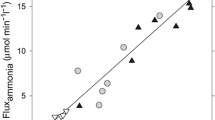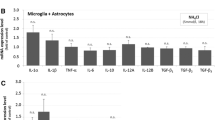Abstract
Recent work has suggested a possible role for nitric oxide (NO) in the development of hepatic encephalopathy (HE). In this study, we examined the effect of ammonia and manganese, factors implicated in the pathogenesis of HE, on the transport of arginine (a precursor of NO) into primary cultures of astrocytes. Treatment with 5 mM ammonia for 1–4 days produced a maximal (53%) increase in L-arginine uptake at 3 days when compared to untreated cells. Kinetic analysis following 4-day treatment with 5 mM ammonia revealed an 82% increase in the Vmax and a 61% increase in the Km, value. Similar analysis with 100 μM manganese showed a 101% increase in Vmax and a 131% increase in the Km value. These results suggest that both manganese and ammonia alter L-arginine uptake by modifying the transporter for arginine. A decrease of 32% in the non-saturable component of L-arginine transport was also observed following treatment with ammonia. When cultures were treated separately with 5 mM ammonia and 100 μM manganese for 2 days, the uptake of L-arginine increased by 41% and 57%, respectively. Combined exposure led to no further increase in uptake. Our results suggest that ammonia and manganese may contribute to the pathogenesis of HE by influencing arginine transport and thus possibly NO synthesis in astrocytes.
Similar content being viewed by others
REFERENCES
Norenberg, M. D., Mozes, L. W., Norenberg, L. O. B., and Gregorios, J. B. 1986. Effects of ammonia in primary astrocyte cultures: Morphological and biochemical considerations. Pages 353–362, in Grisar, T., Franck, G., Hertz, L., Norton, W. T., Sensenbrenner, M., and Woodbury, D. M. (eds.), Dynamic Properties of Glia cells II: Cellular and Molecular Aspects, Pergamon Press, Oxford.
Jessy, J., Mans, A. M., DeJoseph, M. R., and Hawkins, R. A. 1990. Hyperammonaemia causes many of the changes found after portacaval shunting. Biochem. J. 272:311–317.
Pomier Layrargues, G., Spahr, L., and Butterworth, R. F. 1995. Increased manganese concentrations in pallidum of cirrhotic patients. Lancet 345:735.
Krieger, D., Krieger, S., Jansen, O., Gass, P., Theilmann, L., and Lichtnecker, H. 1995. Manganese and chronic hepatic encephalopathy. Lancet 346:270–274.
Kulisevsky, J., Pujol, J., Junque, C., Deus, J., Balanzo, J., and Capdevila, A. 1993. MRI pallidal hyperintensity and brain atrophy in cirrhotic patients: two different MRI patterns of clinical deterioration? Neurology 43:2570–2573.
Inoue, E., Hori, S., Narumi, Y., Fujita, M., Kuriyama, K., Kadota, T., and Kuroda, C. H. 1991. Portal-systemic encephalopathy: presence of basal ganglia lesions with high signal intensity on MRI images. Radiology 179:551–555.
Norenberg, M. D. 1987. The role of astrocytes in hepatic encephalopathy. Neurochem. Pathol. 6:13–34.
Gregorios, J. B., Mozes, L. W., Norenberg, L. O. B., and Norenberg, M. D. 1985. Morphologic effects of ammonia on primary astrocyte cultures. I. Light microscopic studies. J. Neuropathol. Exp. Neurol. 44:397–403.
Gregorios, J. B., Mozes, L. W., and Norenberg, M. D. 1985. Morphologic effects of ammonia on primary astrocyte cultures. II. Electron microscopic studies. J. Neuropathol. Exp. Neurol. 44:404–414.
Aschner, M., Gannon, M., and Kimelberg, H. K. 1992. Manganese uptake and efflux in cultured rat astrocytes. J. Neurochem. 58:730–735.
Tholey, G., Ledig, M., Mandel, P., Sargentini, L., Frivold, A. H., Leroy, M., Grippo, A. A., and Wedler, F. C. 1987. Concentrations of physiologically important metal ions in glial cells cultured from chick cerebral cortex. Neurochem. Res. 12:45–50.
Pentschew, A., Ebner, F. F., and Kovatch, R. M. 1963. Experimental manganese encephalopathy in monkeys: a preliminary report. J. Neuropathol. Exp. Neurol. 22:488–499.
Rao, V. L. R., Audet, R. M., and Butterworth, R. F. 1995. Increased nitric oxide synthase activities and L-[3H] arginine uptake in brain following portacaval anastomosis. J. Neurochem. 65:677–681.
Norenberg, M. D., and Itzhak, Y. 1995. Acute liver failure and hyperammonemia increase nitric oxide synthase in mouse brain. Soc. Neurosci. Absts. 21:869.
Kosenko, E., Kaminsky, Y., Grau, E., Miñana, M.-D., Grisolía, S., and Felipo, V. 1995. Nitroarginine, an inhibitor of nitric oxide synthetase, attenuates ammonia toxicity and ammonia-induced alterations in brain metabolism. Neurochem. Res. 20:381–386.
Palmer, R. M. J., Ashton, D. S., and Moncada, S. 1988. Vascular endothelial cells synthesize nitric oxide from L-arginine. Nature 333:664–666.
Knowles, R. G., Palacios, M., Palmer, R. M. J., and Moncada, S. 1989. Formation of nitric oxide from L-arginine in the central nervous system: a transduction mechanism for the stimulation of the soluble guanylate cyclase. Proc. Natl. Acad. Sci. USA 86:5159–5162.
Garthwaite, J., Garthwaite, G., Palmer, R. M. J., and Moncada, S. 1989. NMDA receptor activation induces nitric oxide synthesis from arginine in rat brain slices. Eur. J. Pharmacol. 172:413–416.
Lajtha, A., and Sershen, H. 1974. Substrate specificity of uptake of diamines in mouse brain slices. Arch. Biochem. Biophys. 165:539–547.
Christensen, H. N. 1990. Role of amino acid transport and countertransport in nutrition and metabolism. Physiol. Rev. 70:43–77.
Kim, J. W., Closs, E. I., Albritton, L. M., and Cunningham, J. M. 1991. Transport of cationic amino acids by the mouse ecotropic retrovirus receptor. Nature 352:725–728.
Wang, H., Kavanaugh, M. P., North, R. A., and Kabat, D. 1991. Cell-surface receptor for ecotropic murine retroviruses is a basic amino-acid transporter. Nature 352:729–731.
Closs, E. I., Albritton, L. M., Kim, J. W., and Cunningham, J. M. 1993. Identification of a low affinity, high capacity transporter of cationic amino acids in mouse liver. J. Biol. Chem. 268:7538–7544.
Hazell, A. S., and Norenberg, M. D. 1996. Ammonia and manganese increase arginine uptake in cultured astrocytes. J. Neurochem. 66:S69.
Booher, J., and Sensenbrenner, M. 1972. Growth and cultivation of dissociated neurons and glial cells from embryonic chick, rat, and human brain in flask cultures. Neurobiol. 2:97–105.
Lowry, O. H., Rosebrough, N. J., Farr, A. L., and Randall, R. J. 1951. Protein measurement with the Folin phenol reagent. J. Biol. Chem. 193:265–275.
Merrill, J., and Murphy, S. 1996. Nitric oxide. Pages 263–281, in Aschner, M., and Kimelberg, H. K. (eds.), The Role of Glia in Neurotoxicity, CRC Press, Boca Raton.
Rao, V. L. R., Audet, R. M., and Butterworth, R. F. 1997. Portacaval shunting and hyperammonemia stimulate the uptake of L-[3H] arginine but not of L-[3H]nitroarginine into rat brain synaptosomes. J. Neurochem. 68:337–343.
Schmidlin, A., and Wiesinger, H. 1994. Transport of L-arginine in cultured glial cells. Glia 11:262–268.
Schmidlin, A., and Wiesinger, H. 1995. Stimulation of arginine transport and nitric oxide production by lipopolysaccharide is mediated by different signaling pathways in astrocytes. J. Neurochem. 65:590–594.
Chesney, R. W., Jolly, K., Zelikovic, I., Iwahashi, C., and Lohstroh, P. 1989. Increased Na+-taurine symporter in rat renal brush border membranes: Preformed or newly synthesized? FASEB J. 3:2081–2085.
O'Connor, J. E., Guerri, C., and Grisolia, S. 1984. Effects of ammonia on synaptosomal membranes. Biochem. Biophys. Res. Commun. 119:516–523.
Lenaz, G., Curatola, G., and Masotti, L. 1975. Perturbation of membrane fluidity. J. Bioenerg. 7:223–299.
Konji, V., Montag, A., Sandri, G., Nordenbrand, K., and Ernster, L. 1985. Transport of Ca2+ and Mn2+ by mitochondria from rat liver, heart and brain. Biochimie 67:1241–1250.
Casado, M., Zafra, F., Aragón, C., and Giménez, C. 1991. Activation of high-affinity uptake of glutamate by phorbol esters in primary glial cell cultures. J. Neurochem. 57:1185–1190.
Casado, M., Bendahan, A., Zafra, F., Danbolt, N. C., Aragón, C., and Giménez, C., and Kanner, B. I. 1993. Phosphorylation and modulation of brain glutamate transporters by protein kinase C. J. Biol. Chem. 268:27313–27317.
Dowd, L. A., and Robinson, M. B. 1996. Rapid stimulation of EAAC1–mediated Na+-dependent L-glutamate transport activity in C6 glioma cells by phorbol ester. J. Neurochem. 67:508–516.
Klarlund, J. K., Bradford, A. P., Milla, M. G., and Czech, M. P. 1990. Purification of a novel insulin-stimulated protein kinase from rat liver. J. Biol. Chem. 265:227.
Koland, J. G., and Cerione, R. A. 1990. Activation of the EGF receptor tyrosine kinase by divalent metal ions: comparison of holoreceptor and isolated kinase domain properties. Biochim. Biophys. Acta 1052:489–498.
Kanamori, K., and Ross, B. D. 1997. Glial alkalinization detected in vivo by 1H-15H heteronuclear multiple-quantum coherence-transfer NMR in severely hyperammonemic rat. J. Neurochem. 68:1209–1220.
Albrecht, J., Hilgier, W., and Rafalowska, U. 1990. Activation of arginine metabolism to glutamate in rat brain synaptosomes in thioacetamide-induced hepatic encephalopathy: an adaptive response? J. Neurosci. Res. 25:125–130.
Albrecht, J., and Hilgier, W. 1986. Arginine in thioacetamide-induced hepatogenic encephalopathy in rats: activation of enzymes of arginine metabolism to glutamate. Acta Neurol. Scand. 73:498–501.
Lavoie, J., Giguere, J. F., Pomier Layrargues, G., and Butterworth, R. F. 1987. Amino acid changes in autopsied brain tissue from cirrhotic patients with hepatic encephalopathy. J. Neurochem. 49:692–697.
Mans, A. M., DeJoseph, M. R., and Hawkins, R. A. 1994. Metabolic abnormalities and grade of encephalopathy in acute hepatic failure. J. Neurochem. 63:1829–1838.
Author information
Authors and Affiliations
Rights and permissions
About this article
Cite this article
Hazell, A.S., Norenberg, M.D. Ammonia and Manganese Increase Arginine Uptake in Cultured Astrocytes. Neurochem Res 23, 869–873 (1998). https://doi.org/10.1023/A:1022411012512
Issue Date:
DOI: https://doi.org/10.1023/A:1022411012512




